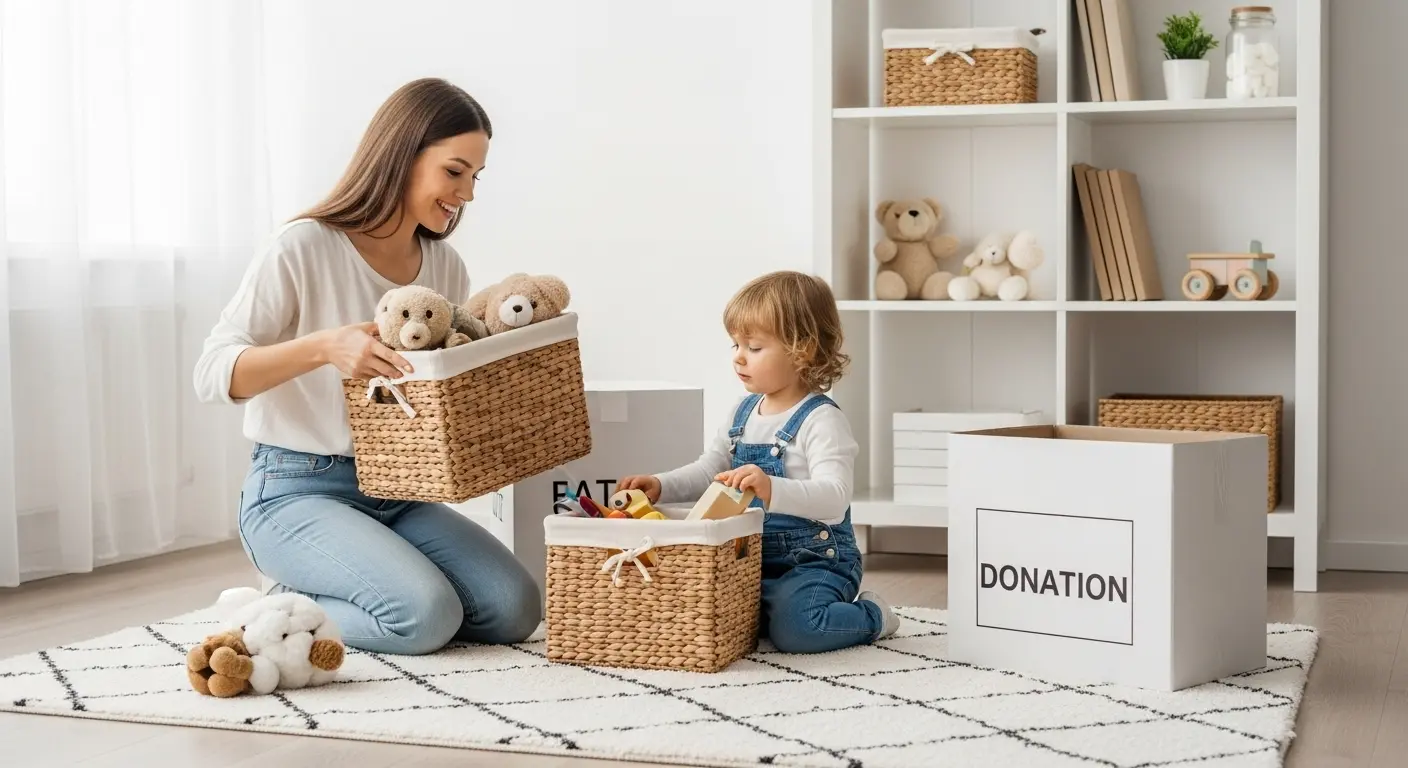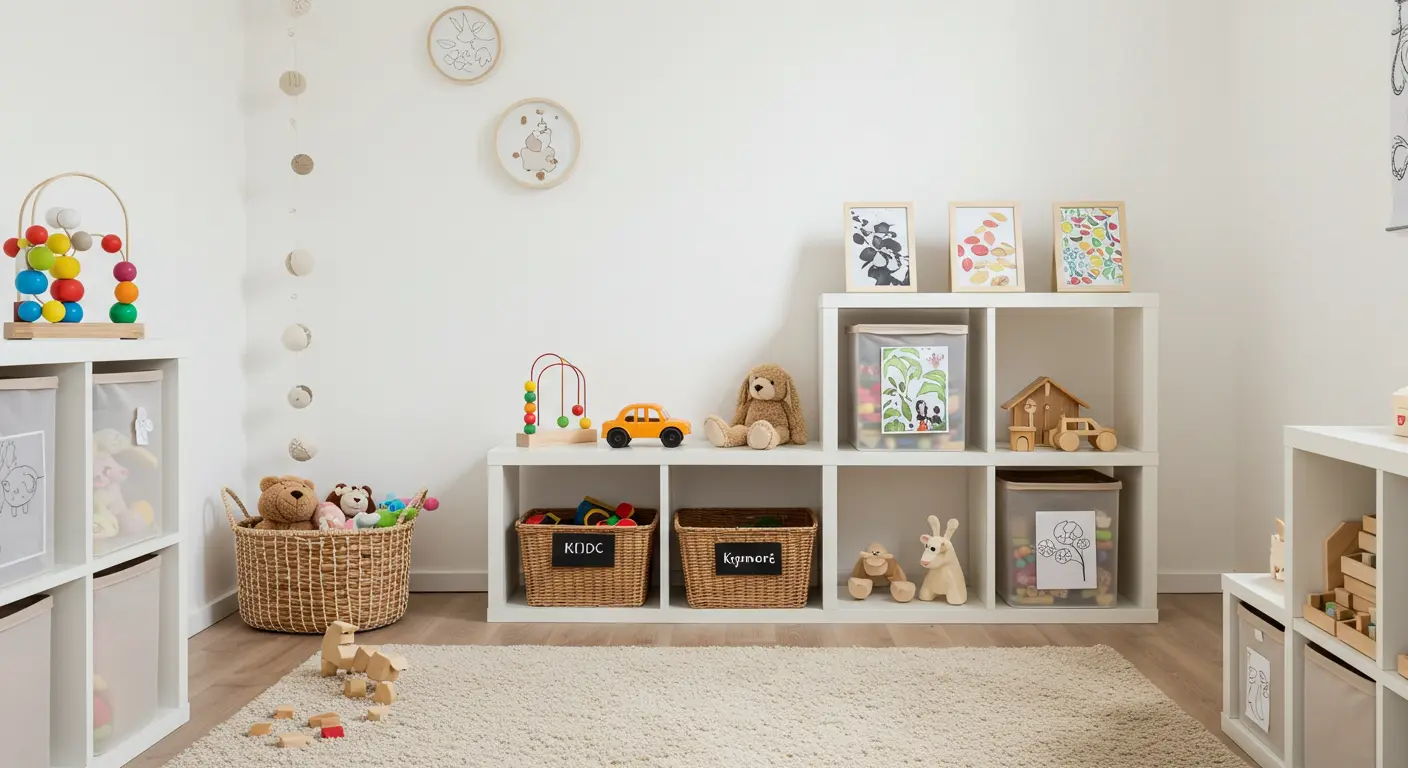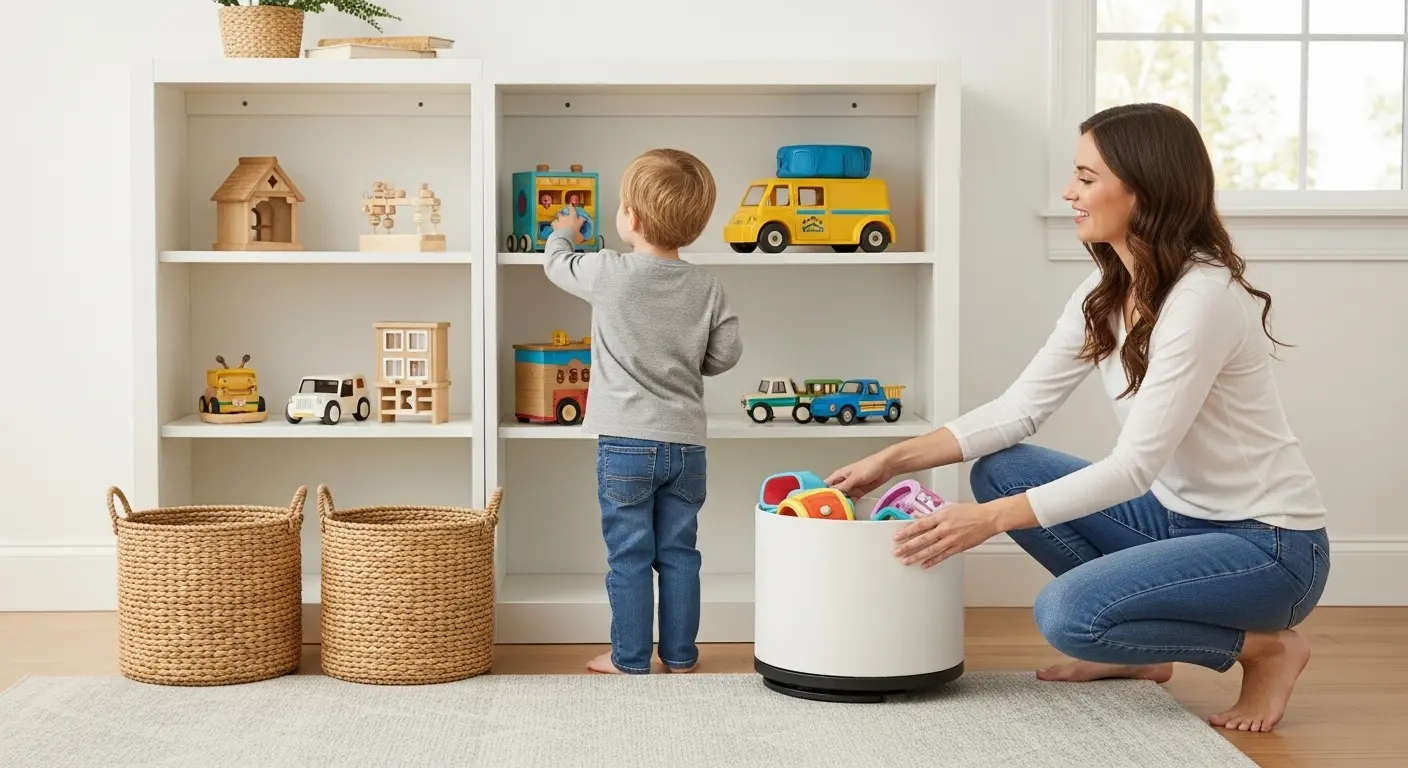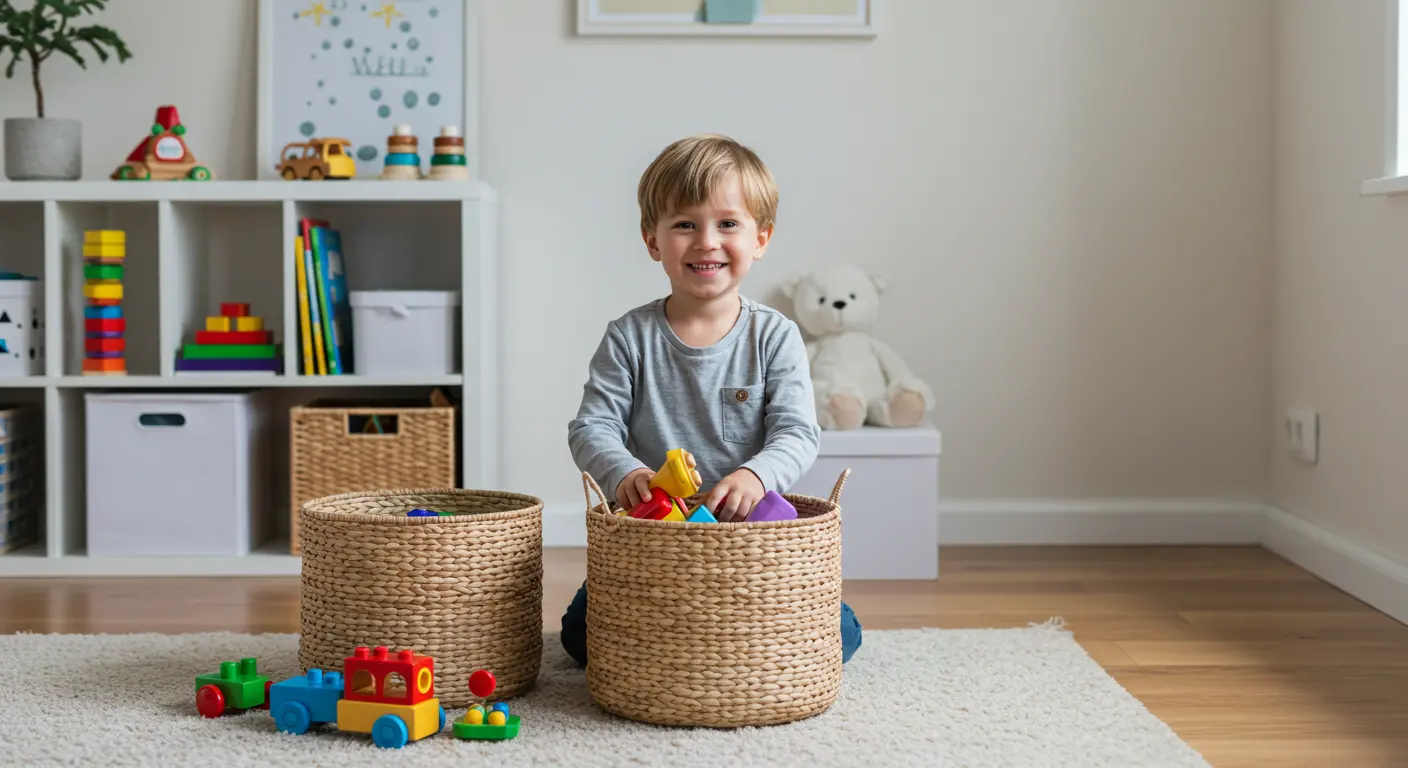
Have you ever noticed that sometimes, the more toys a child has, the less they play? The idea of fewer toys, more fun is not only possible—it’s extremely beneficial! An organized space, free from excess and thoughtfully designed, greatly stimulates children’s creativity, focus, and autonomy.
In this article, you’ll discover how to transform the organization of children’s spaces into something simple, light, and functional, creating an environment that offers more fun, more connection, and much less clutter—all inspired by minimalism.
Why Do Fewer Toys Lead to More Fun?
It may seem contradictory, but when the environment has fewer toys, it becomes much more stimulating, creative, and functional for the child. The concept of fewer toys, more fun is not just an aesthetic matter—it’s a strategy that directly benefits child development.
Benefits for Child Development
When the environment is cleaner, organized, and free from excess, the child develops fundamental skills. Fewer toys mean more concentration, more exploration, and more imagination. With fewer stimuli competing for attention, they can focus longer on each activity, delve deeper into play, and engage much more meaningfully.
Furthermore, having access to a smaller number of objects helps develop autonomy, as the child can easily see, choose, and access everything without feeling overwhelmed.
How an Excess of Toys Harms
Many parents believe that offering a large quantity of toys equates to more fun, but the effect is often the opposite. Excess creates sensory overload, making it difficult for the child to choose what to play with. This leads to disorganization, quick loss of interest, and even frustration.
With so many visual stimuli, it’s common for little ones to feel confused, jump from one activity to another, and not be able to delve deeply into any of them. This not only affects leisure time but also interferes with the development of concentration, creativity, and a sense of order.
Less Is More: The Formula for Richer Play
By reducing the number of toys, the space transforms into a calmer, more organized environment conducive to development. The child begins to use their imagination more, creating scenarios, stories, and different ways to interact with the same objects.
This concept of fewer toys, more fun doesn’t mean restricting, but rather qualifying what remains in the space. That is, fewer physical objects and more opportunities to create, imagine, and explore freely.
Organizing Children’s Spaces: Start with Decluttering
The first step to applying the concept of fewer toys, more fun is to look at what already exists in the space and begin a conscious process of decluttering. When there’s less, organization becomes natural, the environment feels lighter, and fun flows with much more quality.

How to Sort Toys
Before organizing, it’s essential to understand what truly makes sense to keep in the environment. To do this, follow a simple and efficient step-by-step guide:
- Evaluate: Does the child use it? like it? does it have sentimental value?
- Is it whole and functional? Broken or unusable toys can be discarded or recycled.
- Is it appropriate for their current age and stage?
- Does it contribute to development, creativity, or fun?
This sorting should be done consciously, prioritizing quality, functionality, and meaning, not quantity.
Playful and Affective Decluttering Techniques
Involving the child in the decluttering process makes all the difference. When they understand that their toys can have a new home and make other children happy, the process becomes much more natural and light.
Practical tips to make this moment easier and even fun:
- Create a “Donation Box”, decorated by the child themselves.
- Tell stories about how the toys will make other children happy.
- Propose a “Space Challenge”: choose which toys deserve to occupy the space and which have already served their purpose.
- Turn decluttering into a game, like the “Traveling Toy”, which goes on a new adventure in another child’s home.
This is the essence of fewer toys, more fun applied in practice.
How to Avoid Future Accumulation
Maintaining the concept of fewer toys, more fun requires small changes in daily family habits:
- Adopt the “one in, one out” rule: when a new toy arrives, another needs to be donated.
- Encourage gifts that are experiences, such as outings, books, workshops, and not just objects.
- Periodically review the space with the child, reinforcing the value of keeping only what makes sense.
- Talk about conscious consumption and the difference between needing and wanting.
How to Organize Toys Practically and Visually
After decluttering, comes the most enjoyable stage: thinking about functional, visual, and accessible organization. Following the concept of fewer toys, more fun, the goal is to create a simple system where the child can see, access, and put away their items autonomously.

Simple and Accessible Systems for Children
Organization should be designed from the child’s perspective. The easier it is for them to understand where things are, the greater their autonomy will be when playing—and putting things away.
Solutions that work very well:
- Low shelves: keep toys and books within reach of little ones.
- Open cubbies: facilitate visualization and prevent accumulation.
- Baskets and organizing bins: great for loose items like blocks, dolls, and art supplies.
- Multifunctional furniture: chests that also serve as benches, shelves that become dividers, among others.
These solutions keep the space organized, beautiful, and aligned with the concept of a functional children’s space.
Visual Techniques that Facilitate Organization
Good organization is not just practical—it also needs to be intuitive for the child. Visual techniques are great allies in this process.
- Illustrated labels: use images, drawings, or photos to identify the contents of each box or basket.
- Colors by categories: creative toys (green), games (blue), dolls (yellow), books (white).
- Transparent boxes or open baskets: allow the child to see what’s inside without having to rummage through everything.
These resources make organization much more efficient and stimulate the development of child autonomy.
Advantages of Accessible Organization
Organizing accessibly brings not only visual beauty but real benefits for the child’s and family’s routine:
- Less time tidying, more time playing.
- The child develops a sense of responsibility and autonomy.
- The space becomes lighter, calmer, and more inviting.
- Ease in choosing toys, promoting focus and creativity.
- Organization is maintained daily with much greater ease.
When the environment is well-organized, the concept of fewer toys, more fun materializes practically and naturally in daily life.
Toy Rotation: The Secret to Less and Better
If there’s one powerful strategy within the concept of fewer toys, more fun, it’s called toy rotation. This simple practice transforms the child’s relationship with their own space and with the objects they possess.

What Is the Toy Rotation Technique?
Toy rotation involves making only a reduced selection of items available at a time, while the rest are stored out of the child’s sight. Every week, fortnight, or month, the toys are swapped, renewing interest without needing to acquire anything new.
This technique ensures that toys are constantly rediscovered, keeping the environment more organized and stimulating.
Direct Benefits for the Child
Rotation is not just about organization—it has profound impacts on child development:
- Maintains constant interest and novelty.
- Stimulates creativity, as the child explores each toy more deeply.
- Reduces boredom and the feeling of “nothing to play with.”
- Promotes focus, as fewer options facilitate choice and engagement.
- Teaches the value of caring for and enjoying what they have.
This is the essence of fewer toys, more fun applied in practice.
How to Implement in Practice
Putting this technique into practice is much simpler than it seems.
Follow this step-by-step guide:
- Choose the current toys: select 5 to 10 items to be available.
- Store the rest: use organizing bins, bags, or even a dedicated rotation cabinet.
- Define a rotation frequency: weekly, bi-weekly, or monthly, depending on the family’s routine.
- Observe interests: adjust the available toys according to the child’s current stage, tastes, and interests.
- Include the child in the process: turn the swap into a fun and participatory moment.
With each swap, the environment is renewed, organization is maintained, and the child feels constantly motivated to play, create, and imagine.
If you’re looking for toy suggestions that make a difference, check out our selection of minimalist toys that stimulate development.
Creating Functional Spaces: Play, Create, Organize
Organizing space goes beyond tidying up toys. The concept of fewer toys, more fun also involves thinking about how the environment is distributed, creating functional spaces that stimulate different types of activities, in a light and organized way.
How to Define Zones in Children’s Spaces
Dividing the bedroom or play area into small zones helps the child understand that each space has a function. This brings more focus, organization, and stimulates autonomy.
The main zones you can create are:
- Reading nook: with a low shelf, accessible books, cushions, or a comfortable rug.
- Creativity area: low table, art supplies, building blocks, playdough, LEGO.
- Free space for floor play: for symbolic games, building forts, obstacle courses, or other movement activities.
- Rest zone: a reserved space for relaxing, listening to music, or simply being calm.
Organizing this way makes the environment more intuitive and helps reinforce the idea of fewer toys, more fun, as the child begins to value each activity more.
Choosing Smart Furniture and Solutions
The right furniture makes all the difference in creating a functional, organized, and beautiful space.
Prioritize:
- Low shelves: facilitate access to books and toys.
- Baskets and cubbies: practical, aesthetic, and accessible.
- Multifunctional furniture: beds with drawers, storage benches, tables that can be used for various purposes.
- Area rugs: help to “mark” each zone within the bedroom or play space.
These choices reinforce both the organization of children’s spaces and the child’s autonomy.
Integrating Organization into the Child’s Routine
Organization should be part of the routine in a light, natural, and even fun way. When the space is divided into zones, it becomes much easier for the child to understand where everything should be put away.
Tips to make this part of daily life:
- Create small routines: put everything away before starting a new game.
- Turn organization into a game: who puts things away faster, who organizes books better, etc.
- Use visual aids: labels, symbols, drawings, or photos help the child orient themselves.
- Always reinforce the concept: less clutter, more space to play and have fun.
A well-structured environment not only facilitates the family’s daily life but also stimulates the development of autonomy, responsibility, and creativity.
For more ideas on how to stimulate creativity with organization, check out our article on minimalist and creative children’s rooms.
How to Maintain an Organized Children’s Space Daily
Adopting the concept of fewer toys, more fun isn’t just about organizing once and being done. The true transformation happens when organization becomes part of the family’s routine, in a light, practical, and sustainable way.
Simple and Sustainable Strategies
Maintaining organization daily can (and should) be easy and even enjoyable. With fewer items in the space, everything flows better.
Practices that work:
- Quick daily tidy-up: 5 to 10 minutes before bed is enough to put everything in its place.
- Periodic reviews: once a month, review what makes sense to keep in the space and what can be stored, donated, or swapped.
- Simplify systems: if it’s hard to put away, it’s too complex. Adjust until it’s easy for the child.
- Leverage natural routines: organize upon finishing each activity before starting another.
The secret is to realize that fewer things = less clutter, more free time, and higher quality play.
Involving the Child in Maintenance
When the child actively participates in organization, everything becomes easier, more educational, and even fun. They develop a sense of responsibility, autonomy, and understand that the space is a reflection of the care they put in.

Ways to involve little ones:
- Turn it into a game: “Who puts things away fastest?” or “Let’s organize like it’s a toy store?”
- Use positive reinforcement: praise and reinforce whenever the child participates in organizing.
- Allow choices: let them decide where some items go, within the possibilities of the space.
- Create visual checklists: with images of organized zones, so the child knows how it should look.
Active participation reinforces the very concept of fewer toys, more fun, as everything becomes more accessible, lighter, and functional.
Conscious Consumption as a Family Habit
Maintaining an organized environment is also directly linked to adopting habits of conscious consumption. After all, it’s much easier to maintain organization when we are discerning about what truly enters our home.
Practices to cultivate this habit:
- Reflect before acquiring: Is this really necessary?
- Value gifts that are experiences: outings, courses, family moments, books.
- Talk to the child about choices: teach them early on the difference between wanting and needing.
- Adopt constant reviews: keep the space aligned with the child’s current stage, interests, and needs.
When the family adopts a culture of less, but better, everything becomes simpler—and, consequently, more fun, organized, and functional.
Checklist: How to Organize Children’s Spaces with Fewer Toys
| Action | Benefit | Result |
|---|---|---|
| Sort and declutter | Reduces excess | Less clutter, more focus |
| Adopt toy rotation | Maintains interest | Constant fun with less |
| Organize by categories | Facilitates access and visualization | More autonomous child |
| Create functional zones | Optimizes space and activities | Organized and stimulating environment |
| Light daily maintenance | Sustains daily organization | Less effort, more free time |
| Practice conscious consumption | Prevents accumulation | Lasting organization and higher quality of life |
Conclusion: Less Stuff, More Time, More Fun
The concept of fewer toys, more fun isn’t about restriction, but about creating a space that truly makes sense for the child and the family. When we organize the environment functionally, accessibly, and consciously, we open up space not only in the room but also in the mind, routine, and relationships.
Less stuff means less stress, less clutter, and more time for what truly matters: playing, connecting, imagining, and living quality moments. By applying these strategies, you not only transform the children’s space but also promote a lighter, more conscious, and happier lifestyle.
If this content inspired you, continue exploring Minimals Vibe to discover how minimalism can transform all spaces—and family life.
